The first week of June found us still waiting for a significant change in fishing conditions. The weather was predicted to be showery now – these were blustery days with big black cumulous clouds driving overhead - but little enough fell in our catchments and the rivers remained low. Trout fishing on the Usk produced the odd good fish, mostly to dry fly tactics, but it was often hard work. I saw that Dave Collins from W Herefordshire had a 20 inch trout in a bag of 5 from the upper Wye. Judging by the reports, smaller streams and tributaries of both rivers were being fished much less than usual, which seems a pity. It’s often a good idea to fish well-shaded streams when the going gets tough, even if the water is low. The Lugg and Arrow kept up better than most due to their deep springs in Radnor Forest. However, in my case what was planned to be a mayfly day with a client on the Lugg at Lyepole resulted in more out of season grayling than trout. According to reports, our mayfly hatch both started and finished earlier than usual this year.
Some heavier overnight rain on the 6th seemed to have done the upper Usk a bit of good; while the level barely rose an inch, there was now some colour in the water, pale wateries were hatching through the day and trout were rising steadily again to small dry flies fished up and across. I found that Comparaduns were working well, and all up and down the river anglers were catching at this time. It was a reminder that just a bit of fresh water can make a significant improvement to our fishing chances, but it only lasted for a few hours.
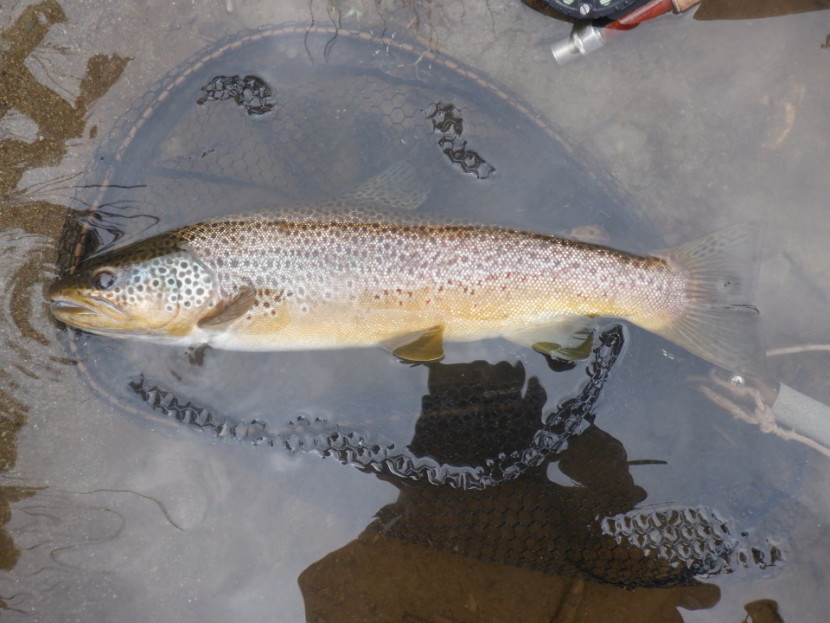 Upper Wye trout - DC from W Herefordshire
Upper Wye trout - DC from W Herefordshire 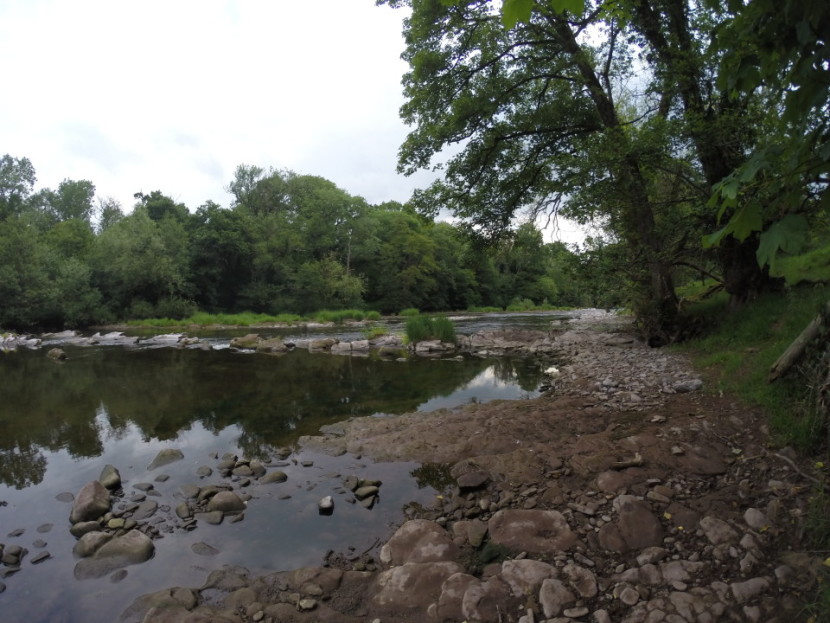 Usk on its bones at Abercynrig - SP from London
Usk on its bones at Abercynrig - SP from London Meanwhile salmon numbers on the Wye were very slowly creeping up towards 200 for the year so far. Just as during May, nearly everything was being caught on beats below Monmouth, especially Wyesham, which actually had 11 fresh fish for the day on 1st June coincident with spring tides. Further upstream it seemed we only had potted fish colouring up as they waited in the pools. Very rarely, one of these would make a mistake. Wyesham lately have been taking more salmon on a daily basis than I have room to record individually, but I note that the four fish of 5th June included a big one of 28.5 pounds (taken on fly). Salmon fishing on the Usk was similarly confined to the lower beats. Further west on the estuaries of rivers like the Loughor, Towy and Teifi, we began to hear that the poachers were taking advantage of the conditions. Fresh salmon and sewin held up in the estuaries waiting for the water to run the rivers are vulnerable to illegal netting and deliberate foul-hooking as NRW are well aware. Meanwhile the legal coracle fishers have also taken full advantage of the sewin queued up in the estuaries.
On the 5th BP from Leominster recorded 9 trout from Llyn Bugeilyn. He was using a weighted Hare’s Ear on the point and a Bibio on the single dropper, which seems a likely combination. JP from St Davids had 8 trout from the Aberystwyth AA water. The following day DL from Chelmsford took a brown trout and a salmon of 10 pounds with a Mepps from Lower Symonds Yat, just below the suspension bridge. DR from Wolverhampton recorded 12 small trout on dries from the Ithon at Llandewi. PB from Churchdown with a friend reported an excellent day at Llangoed and Lower Llanstephan, taking 20 trout to 20 inches on parachute patterns. 20 inches should be an easy 3 pounder. He reported also spawning activity in the shallows and wondered if shad might be responsible. I would have thought not; the shad activity I have seen on occasion is a sort of group sex orgy which goes on in deeper water at dusk. Chub might have been responsible for the commotion in the shallows perhaps?
On the 10th TLQ from Alresford with a friend shared Dinas and Abercynrig and took 20 trout between them. On the following day CE from Worcester was very unhappy with the overgrown banks and lack of access at Arrow Mill. Joe Alexander from Leominster had 3 trout from the Titley beat, but found the fishing difficult in low water. On 11th he did better on the Edw up at Hundred House. This is the top beat on this stream, where the water collects in some slower pools and where we sometimes find some larger fish. On this day he had 14 trout to 12 inches, all on a Parachute Iron Blue.
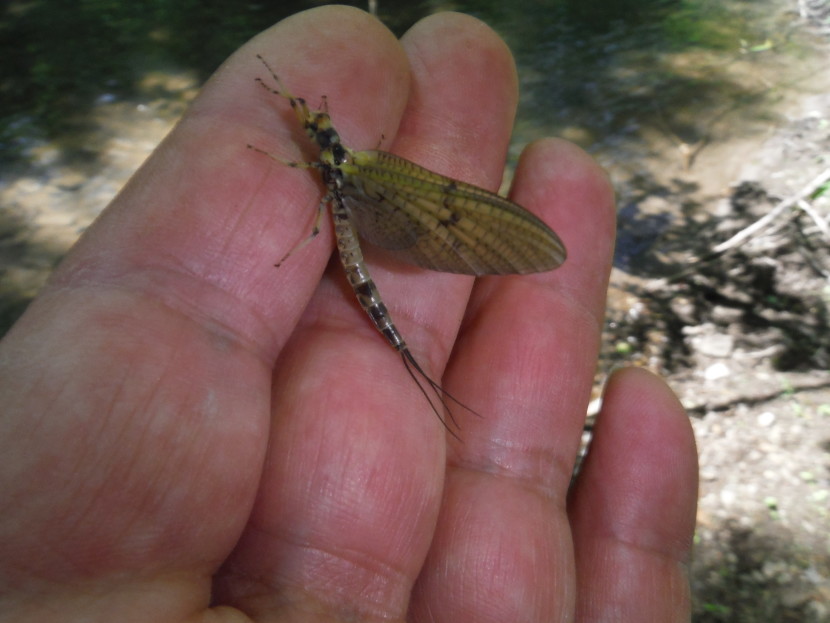 Green drake from the Lugg
Green drake from the Lugg 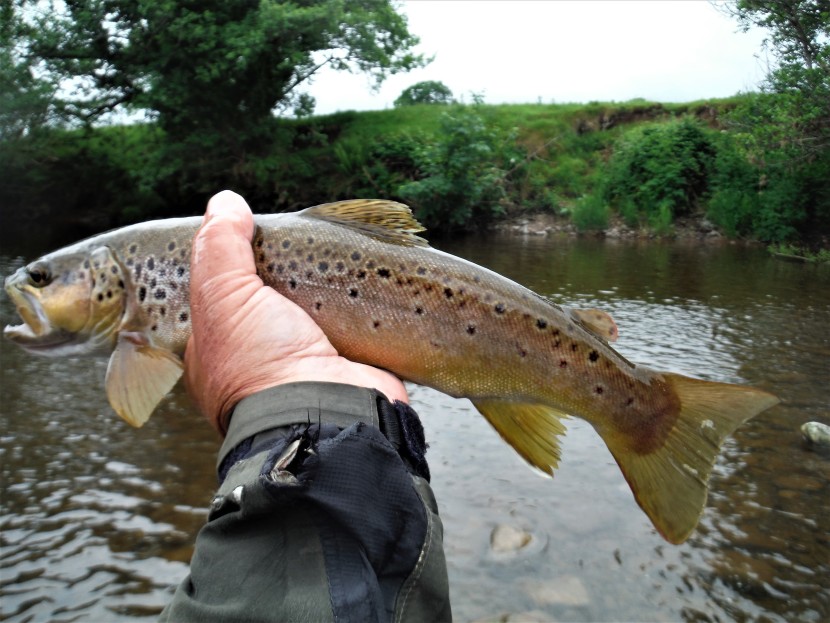 Abercynrig trout on spiders
Abercynrig trout on spiders Again we received some remarkably insensitive complaints about Llwyn On, where it seems some of the customers feel cheated if they don’t catch the appropriate number of trout to match the cash outlay on the ticket. I had a chuckle about this, wondering if when I buy a ticket to shoot 50 clay targets, I should complain or ask for my money back if I don’t hit, let us say, 45 of them. In fact I know some people who can get 45 on occasions, but then my more typical score might be 25. And I know why. When I concentrate and everything goes well, I might manage 35. One day, if I work at it and get much better, I might perhaps get 40. I live in hope. Nobody else can do it for me, but I can read some articles, watch other people and take advice. The alternative of course is to give up and try another sport, but for now I’m minded to keep trying, mainly because I am having fun. The same applies to fishing.
One gentleman obviously feels particularly aggrieved at his lack of success in trout fishing at Llwyn On and complained: “…no fish in the lake and sonar proves it.” Unfortunately for him, simultaneous reports came from other groups who had caught trout on the same day which rather devalued this claim. Another, also unhappy with his results, demanded to know the stocking date in advance as if it might be a sort of human right to be given this information. The WUF replied shortly that “Welsh Water stock the lake fortnightly. They don’t announce dates for obvious reasons.” Quite right too. In the early years of Grafham, it was common to see a procession of anglers in their cars following the stocking lorry round the reservoir. It was not a pretty sight. Angling is a sport, with naturally varying conditions and inevitably varying chances of success, not a market for buying fish. If you find it too difficult and you aren’t enjoying yourself, by all means try something else.
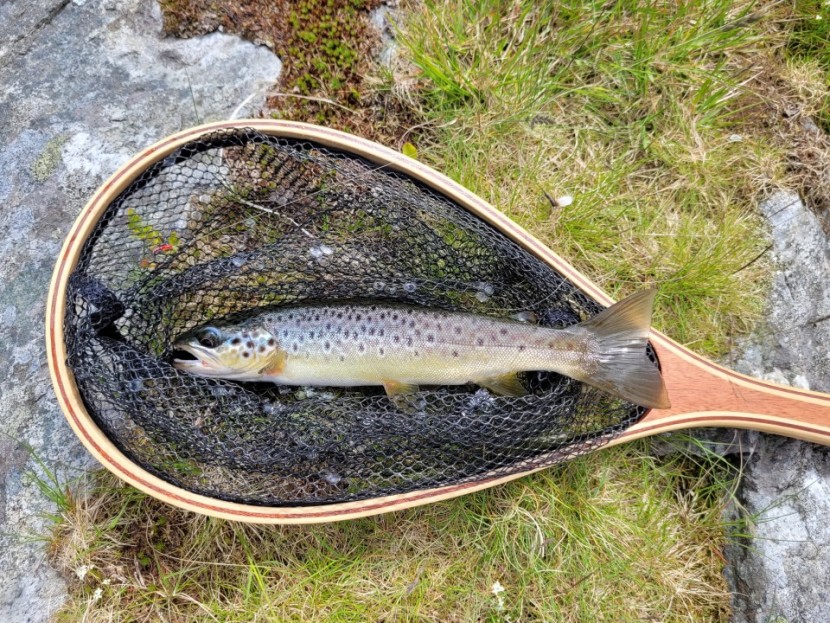 Cwm Silyn trout - MW from Hoylake
Cwm Silyn trout - MW from Hoylake 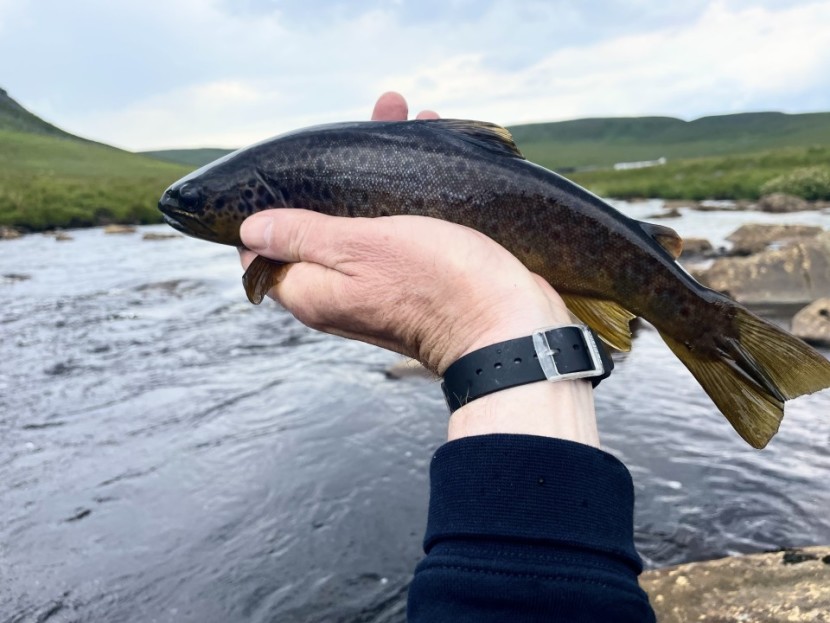 Tees trout - GW from London
Tees trout - GW from London At first the few showers had no effect on our catchments and the weather became warmer, with a heatwave moving up from Spain. The salmon situation continued as before, with almost all the action taking place below Monmouth. Wyesham caught their hundredth fish at about this time, and in fact for those who like to keep a record of such things, Wyesham looks to be one of the most productive beats in the UK this year. I wish I could say the same for the rest of the river! PH from Bath had a difficult day at Talybont Reservoir on the 12th and suggested his own solution: fish evenings from now on rather than all through the hot days. Hope also for a little breeze to ruffle the surface and keep the midges away. TH from Calne fished the new beat at Greta Farm on the 15th and reported 7 trout from 6-10 inches on a small Black Klinkhammer. IC from Gloucestershire fished up at Llyn Bugeilyn with a wind blowing small beetles off the land and caught 20 trout with an imitation. SJ from Warwick with a friend visited the following day, beetles were still falling and they managed 9 with a best fish of 14 inches taking a Deer Hair Sedge pulled through a ripple. That’s a good one for Bugeilyn. SJ gave a good description of the hazards of the lake margin, which in places is composed of peat bogs and ankle trapping holes; I pulled an Achilles tendon here once which was a most painful experience.
 Rectory Pool - upper Wye
Rectory Pool - upper Wye 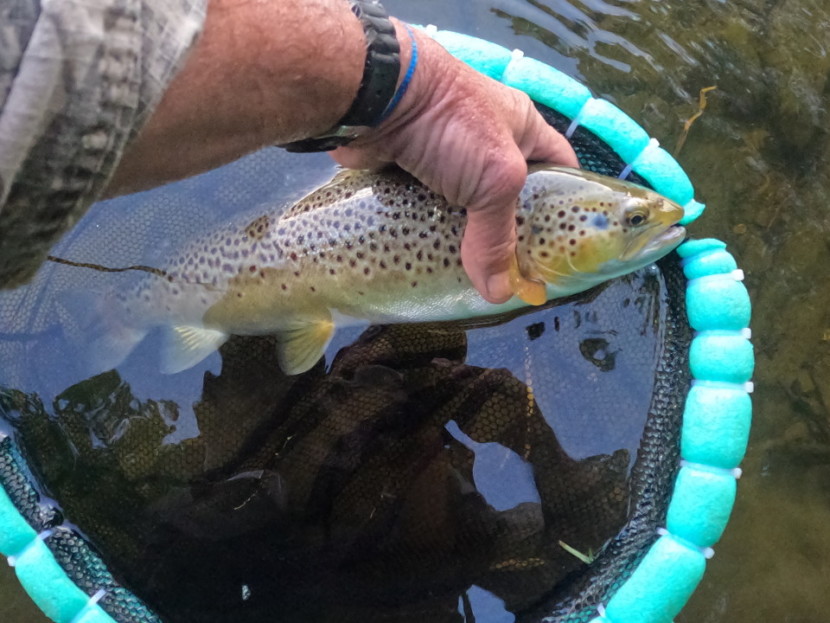 Abernant trout - TR from Capetown
Abernant trout - TR from Capetown The 16th was the first day of the real heat-wave and of course we had an explosion of reports on the opening of a new coarse fishing season on the Wye. AR from Llanelli fished the Usk Reservoir for 6 trout while Joe Alexander was back on the Edw at Hundred House and recorded 10 more trout. SB from Solihull reported 30 grayling and a trout from Craig Lyn. Our mayfly season, such as it was, seemed by now to be more or less done.
Despite the heat at this time, David Burren and I took off for Heale on the Wiltshire Avon to see how the mayfly is doing there. The word was that the real rise on the upper Avon had been occurring at 9 in the evening, but following the general philosophy of “fish while you can” we started at 10 in the morning. There were a lot of early inspections and rejections of the flies, but by midday a steady hatch of mayfly duns was in evidence and fish began to rise with more confidence to both those and our artificials. Despite the warmth, the sky became cloudy with an upstream breeze which helped the casting slightly. This was the first day of the permitted weed cut and a few clumps were floating down from the Upavon beats, but conditions were not too problematic. I fished all through with 4X tippet and a Monnow Gosling on a long-shank size 10 and we ended the day with 28 trout between us, quite a number of them big fish over 20 inches, plus a grayling.
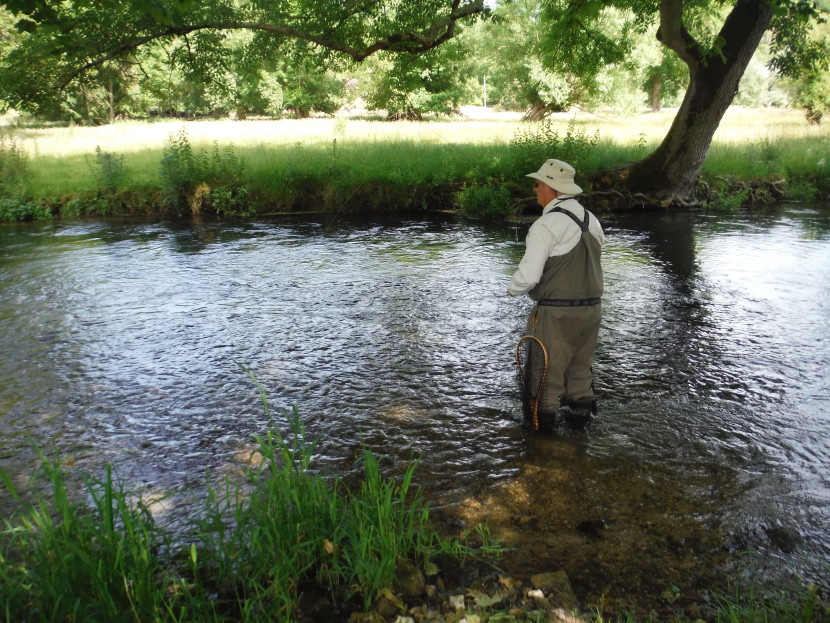 David Burren fishinbg the upper Avon at Heale
David Burren fishinbg the upper Avon at Heale 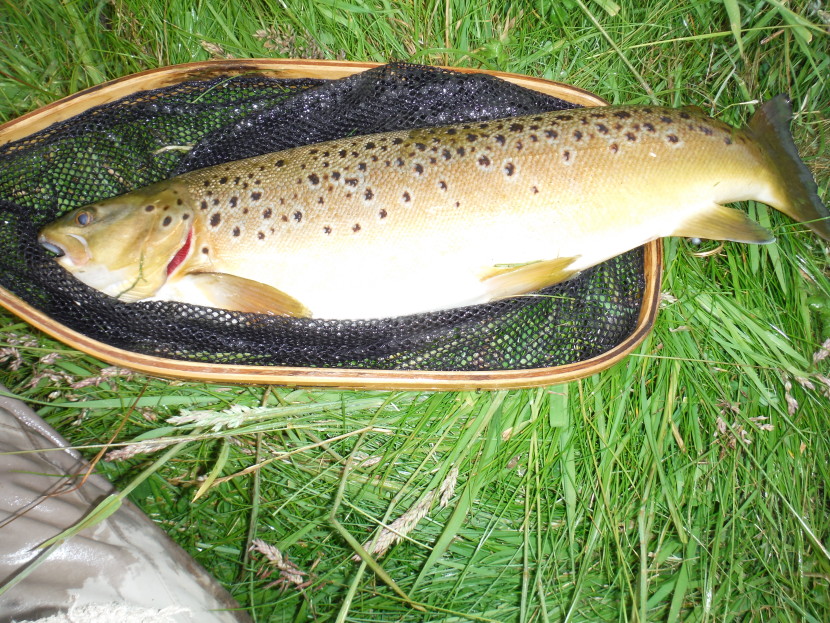 Avon trout
Avon trout 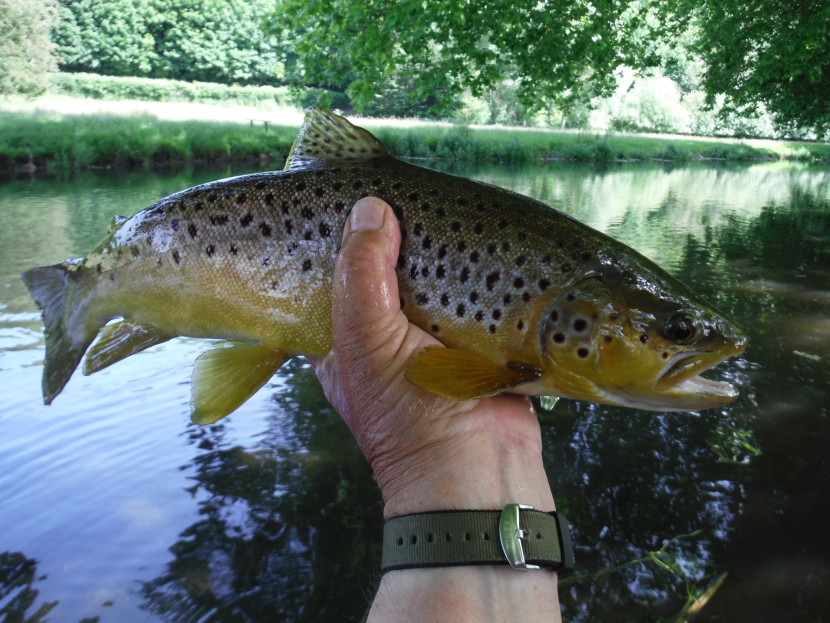 Mayfly feeder from the Avon
Mayfly feeder from the Avon 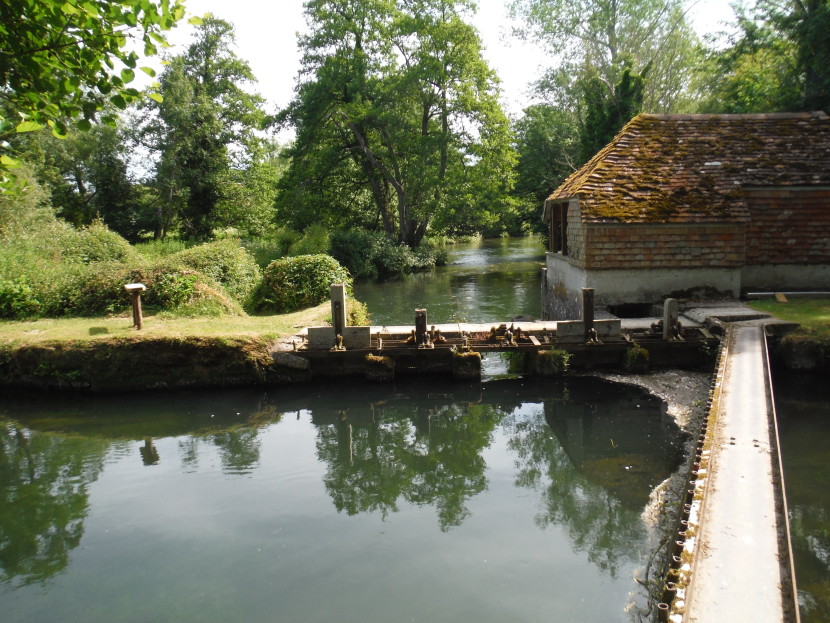 Upper Avon
Upper Avon Low water and a heatwave stresses the river and it certainly stresses some of us at times! We were approaching the conditions when it might be necessary to consider water temperature, even suspend operations for the welfare of the fish, particularly in the case of salmonids. Many of the trout and grayling seemed to be covered with freshwater lice. Joe Alexander from Leominster fished the Arrow at Whittern Lyonshall on the evening of the 17th and stopped a couple of times to take the water temperature, recording 15 degrees. He caught 9 trout in good condition on a small Parachute Greenwells. However, MG from Cheltenham reported the Irfon at Melyn Cildu as: “extremely low…no fish in it…waste of time and money.” I grant that the upper Irfon during an early summer drought is not a choice which many would have made, but there are certainly fish in Melyn Cildu – look at the winter reports for this beat. Similarly, of the coarse fishermen, AH from Exeter with a friend who fished The Creel for 1 barbel and 10 chub, declared himself very disappointed with the conditions, citing recent reports on the Wye’s problems: “…we will be looking for a cleaner and more healthy river in future.”
I wouldn’t write the Wye off quite yet, AH. The following day RL from Woodbridge with two friends fished at Holme Lacey 3 and Lechmere’s Ley and reported catching 17 barbel and 188 chub: “…I don’t think I’ve ever seen such big chub in such numbers…at times you could count 70-80 basking, mostly 4-5 pounds fish…thank you WUF!” In fact along with the good barbel fishing some enormous quantities of chub, literally running from hundreds into thousands, were reported by coarse anglers in June, including a fish of 6 pounds 2 ounces.
Quite apart from the weather and lack of water, this was a problematic weekend. A glitch on the Passport website meant that from late on Friday night, bookings were taken, payments accepted and receipts sent out, but no tickets, directions or maps. As a result, MC from Tamporley with a friend found themselves wandering over the mountains looking for Llynnau Gamalt without a map. They found it and caught some trout with a size 18 Griffiths Gnat. Poor Allyson at the WUF had to sort it all out on the Monday morning!
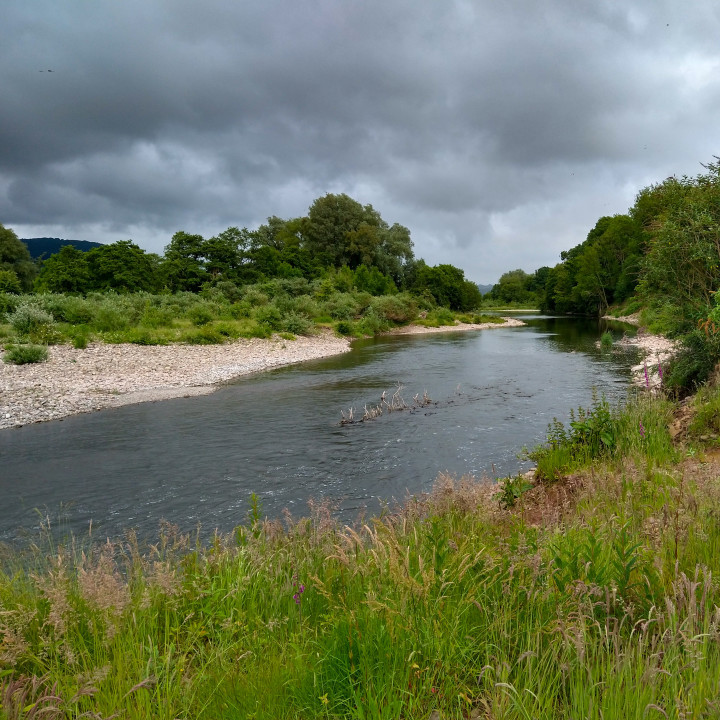 Aberbaiden - PT from Fairford
Aberbaiden - PT from Fairford 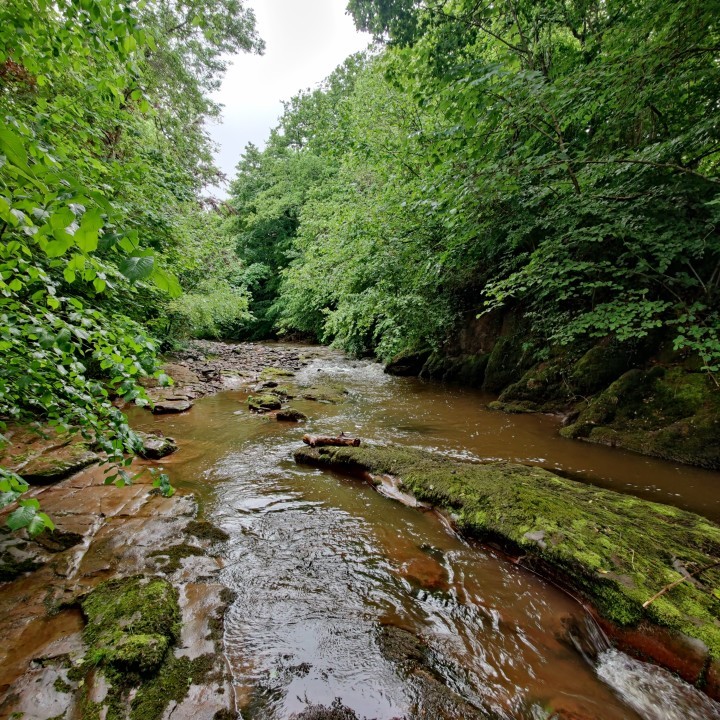 Lower Tarrell - DR from London
Lower Tarrell - DR from London There was some rain on the 18th, but it amounted to very little in the rivers and heat quickly returned. I was intrigued by the report of a large pike’s head seen lying in the shallows at the Abernant beat – presumably a spawning casualty - and wondered which pools locally or upstream that monster had been inhabiting. HP from Johannesburg spent two days fishing the Edw, had half a dozen trout on each occasion and enjoyed staying at the Seven Stars: “Lovely day in paradise…thank you Fishing Passport.”
There was nothing much to report about salmon during this period except that Wyesham at the bottom of the Wye continued to pick up one or two fish a day. Even those catches dropped away as the hot weather continued. There were now showers at times, not enough to affect the river levels yet, but the clouds at least were useful to anglers. We had some brisk winds also. SL from Looe fishing at Upper Tower and ST from Salisbury at Dinas both had 2 pounders from the Usk. HP from Johannesburg had moved on to the Taff Fechan where he caught 17 small trout. CW from Northampton was not happy with his day at Eyton on the 22nd due to the heavy growth on the banks and despite catching 3 trout and 11 grayling. He also pointed out that he had spent 60 pounds in fuel to get there. This is the first complaint that I have heard about fuel costs when linked to fishing trips, but I imagine we will hear many more. Remember it’s wartime now and everything is likely to become more expensive; the price of fuel seemed to go up 10p per litre every time I filled my tank. TR from Swansea reported a sea trout from the Towy at Llandeilo, but there was no information about the size or method of capture. There hadn’t been much news about the sea trout run so far this year.
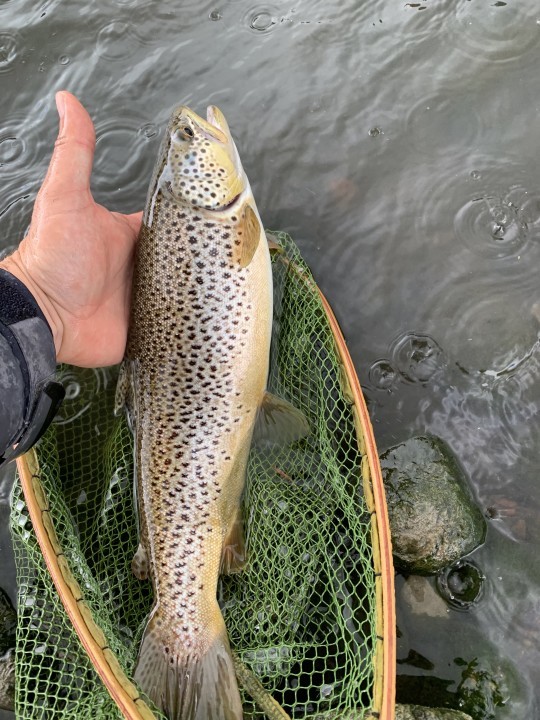 Dinas trout - JS from Lingfield
Dinas trout - JS from Lingfield 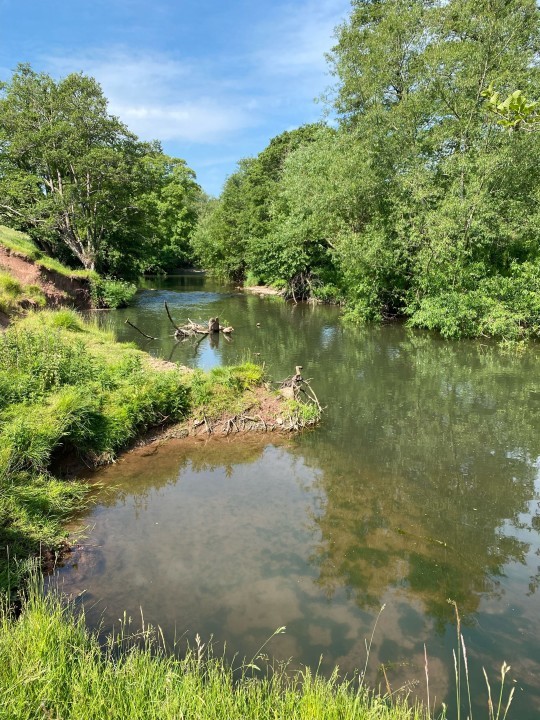 Skenfrith - SC from Hereford
Skenfrith - SC from Hereford The heatwave ended with a pressure drop, cloudy, windy days and numerous showers, some of them briefly quite intense. The rainfall was not enough to make much difference to river levels yet, but the cloud cover certainly seemed to help the fishing. SL from Looe reported another pair of 2 pounders from the Upper Tower beat on the 23rd. MG from Cardiff reported an excellent day on the Usk Reservoir, catching 3 rainbows and 5 browns by pulling traditional flies like Kate MacLaren, Zulu and Black Hopper through the waves. RB from Bromsgrove had a half dozen from the Edw at Hergest on dries with lots of rising fish. GW from London had 24 trout on dries from the Raby Estate water of the Tees. Stone flies, olives and the odd true mayfly were hatching off. HP from Johannesburg was back at the Hergest Edw on the 25th and took 30 trout. JS from Lingfield with a friend had a very good day at Dinas and reported 22 trout on nymphs and F-flies.
RW from Hereford fished the top of the Usk at Cwmwysg Ganol using those little French Perdigon nymphs which sink like stones. He had 10 trout, mostly small, but one of 16 inches. At the bottom of the Wye Bigsweir reported 3 salmon on the 28th and Simon MacLucas caught one of 74cm on fly at Redbrook. Showers characterised the end of the month and the Wye had risen just a couple of inches, which would hardly do much for the salmon run. Further west the situation looked a little better. The little Loughor apparently collected more than its share of the rain, went up a foot and brought in some silver with the flood. Steffan Jones who fished at Ammanford was first to alert us to these fresh fish. WS from Cardiff fished the Towy at Llandeilo and reported 2 sewin.
One bit of good news is that Forestry England have agreed to re-open fishing on two Wild Streams: Blackpool Brook and Cannop Brook. To remind everybody, the problem here is an outbreak of crayfish plague which was detected last year in the Soudley Brook (of which Blackpool is a branch). The plague is carried by the invasive signal crayfish (which have already invaded the Cannop Brook), but invariably kills the native white claw crayfish (which still have a stronghold in Soudley Brook). The shut-down was an attempt to prevent transmission of the plague bacillus or indeed the eggs of crayfish between the streams. Currently we wait to find out whether the plague is still present after the winter’s cold weather. However, the re-opening is on the strict understanding that all measures are taken to prevent cross-contamination recurring again. Therefore, please read and adhere to the guidelines already given, now with the important extra measure of spraying your waders, nets and tackle with Virkon aquatic disinfectant before fishing. Virkon is easily available online and from tackle shops. Forest Rangers have been asked to check that anglers have Virkon sprayers with them in their cars, so please comply.
The wonder of the world
The beauty and the power,
The shapes of things,
Their colours, lights and shades,
These I saw.
Look ye also while life lasts.
I re-read an old favourite this month, a book which has given me tremendous pleasure over the years. This was Confessions of a Carp Fisher by “BB.” Denys Watkins-Pitchford, who sometimes used the pseudonym BB after the cartridge shot size he used when wild fowling, was a writer and novelist for both children and adults, an anthologist, poet, a talented artist, sometime teacher, naturalist and skilled all-round angler and shot. He prefaced all his books with the poem above, which some think he wrote, but was probably taken from an anonymous inscription on an old Cumbrian tomb stone. BB was above all very sensitive to what Lawrence Durrell once called the “spirit of place.” Landscape and weather affect the mood of human beings, which is why so many of us love the countryside and feel happiest there, but then again not many of us can express and transmit the mood and feelings which the surroundings engender. Take this example from a wonderful and succinct writer, but in no way a sentimentalist. In just two and a half sentences BB sets the scene for catching a large tench in the warm dusk long ago:
“I caught my five pounder in that witching hour when other anglers have packed up and departed and the rats had begun to emerge from the reedy banks on either hand. There was little sound but the distant throb of heavily-laden bombers proceeding across the sky in the direction of Germany. And just at that moment when my float became difficult to see…”
 Confessions of a Carp Fisher
Confessions of a Carp Fisher  A corner of a Carp Pool
A corner of a Carp Pool I have been a tench fisher in my time – there’s a confession - so I get this. Consider the effect of the brief lines above from a master wordsmith. He transmits the information that it’s dusk on a warm summer evening in the early 1940s, he is on a lake somewhere in the East Midlands, that he is float fishing for tench and that the float, while now difficult to see through the gathering gloom, is about to move… In fact he transmits the essence of tench fishing and any reader who has fallen under the charm of that particular branch of the sport will be there with him, staring at that red topped quill float and expecting it to begin to bob. He also, almost incidentally, transmits the knowledge that momentous and tragic affairs are going on in the wider world, but he – and we – sitting with rod and quill float beside a Northamptonshire pond, have escaped that for a few hours at least.
Watkins-Pitchford was born in 1905 the child of a rural vicar in Northamptonshire, and had a rather lonely childhood as after various illnesses he was considered too delicate for the rigours of the public schools of the day. Instead he was educated at home, but with the incidental blessing of being allowed to roam for long hours through the surrounding woods and fields with gun and fishing tackle. He went to art school and studied in Paris for a while, before becoming an art master at Rugby School for 17 years. For the rest of his life he was a full time professional writer and illustrator, enjoying enormous success especially with children’s books such as The Little Grey Men, with anthologies such as The Fisherman’s Bedside Book and The Shooting Man’s Bedside Book, and a very creditable attempt to describe the world through the eyes of a wild animal in Wild Lone. To this tale of a Midland fox in hunting country he brought the detailed observation of a naturalist and the insight of a poet; it compares well with books of the time in the same genre such as Henry Williamson’s Tarka the Otter and Salar the Salmon. The successful author had his sorrows: the death of his older brother as a child; the death of his own son at 7 years old; the premature death of his wife.
 Denys Watkins-Pitchford
Denys Watkins-Pitchford  Grey ghost
Grey ghost Generally BB used the lead shot pseudonym for his authorship and his own name of Denys Watkins-Pitchford for his illustrations. When both occur in the same volume it looks slightly odd, but you get used to the idea. I encountered at a very young age BB’s writing and wood cut illustrations when I was given The Forest of Boland Light Railway one Christmas time. I was absolutely fascinated with it. The children’s story was about a tribe of gnomes who lived in a great forest, mined for metals and gems and somehow built for themselves a miniature steam railway line. I could relate to this; I spent most of my childhood holidays living in the middle of a great forest which also in those days still had full-sized steam engines, in this case pulling coal wagons. The Forest of Dean was already a magic place to me; only the gnomes were missing and, who knows, they might have been there somewhere.
BB’s book also had a villain in the person of Shera Beg and his band of leprechauns. Shera Beg came to a sticky end at the conclusion, which made it just perfect for a child! Years later I read it to my own children and I do believe it has been read again to grandchildren. It’s a little known and slightly surprising fact that Watkins-Pitchford himself had a belief in what he called “little people.” He was generally reticent on the subject but when pressed he would claim quite definitely that at the age of about four he had seen one. Some of his descriptions of old anglers, particularly the priest Father Angelus in Confessions of a Carp Fisher, certainly hint at a belief in ghosts.
 Carp basking
Carp basking  Power and strength
Power and strength I also loved BB’s books on wild-fowling such as Dark Estuary and Tide’s Ending, the last of them being Confessions of a Coastal Gunner. However, he was perhaps at his best on angling and Confessions of a Carp Fisherman is undoubtedly the best book which has ever been written on carp fishing, even though the sport has changed immensely – and not for the better some might say – since the 1950 publishing date. This was a time when it was very difficult to catch a carp over double figures in weight and a great mysticism was prevalent about the supposed cunning and size of the fish. Split cane rods, centre pin rather than fixed spool reels, oiled silk lines and even alasticum wire as a hook length were in use. The record then stood at 23 pounds. It was known that much bigger fish existed, but – probably because of the limitations of the tackle – they were considered to be virtually uncatchable.
Interestingly the book includes early correspondence with Richard Walker, who a few years later in Herefordshire’s Redmire Pool went on to catch Clarissa, the record breaking 44 pounder. Dick Walker was our boyhood hero by a country mile; we hung on his every pronouncement! Confessions takes the reader to the most romantic fishing places, both here and abroad. Why is it, BB ponders, that the best carp waters are found at the bottom of steep narrow lanes? It’s true; they always are. BB tells the story of the Old Copper Mine in Devon; one day I will write the story of 20 years fishing Hatchlands Lake near Clandon in Surrey. Confessions includes an account of fishing Lake Balaton’s reed beds for giant carp just after the Great War. There is a statue there by that vast Hungarian lake of a professional fisherman, leaning forward from his punt with a great trident poised. I believe there is a similar statue on the edge of another wilderness of reeds, part of it now a national park and crossing two countries now. This is the delta of the River Neretva where it reaches the Adriatic in Croatia and the linked wetland of Hutovo Blato in Herzegovina. The channels of pure limestone water were famous for legendary great carp which were once speared from the prows of canoes. My son now has a brother-in-law who makes his living with punts and heavy machinery both digging and cleaning out Sussex ponds. An interesting profession, you might think, and as a suitable adjunct he is also a mad-keen carp angler. “Buy him BB’s Confessions” I suggested to Malcolm who was wondering what to get him for Christmas, and I was pleased to hear that he loved it too.
 Richard Walker
Richard Walker  The tackle of times past
The tackle of times past I used to be a bit of a republican in my youth. I used to be a lot of things. However, knocking around the world a bit, even trying a little nation-building myself, convinced me over time that the system we have in the UK is better, at least for us, than anything else I could imagine. Just think how would it be if we had to elect as President one of those tarnished elderly politicians who like to put themselves forward as senior statesmen? Do we really want our armed forces swearing loyalty to such a person? Better by far to leave those self-important characters to make their money on the lecture circuit and stick with the system we have got. In fact I think constitutional monarchies generally work quite well. It’s not only Britons who have such ideas. I used to have a boss seconded from State Department, who had formerly been the US Consul in Belgrade. At a reception in St James Palace during the early 90s he cornered our Queen in an attempt to persuade her that the solution for an unstable Yugoslavia was to restore the monarchy in the person of Crown Prince Alexander. A couple of aides had to come to rescue HRH from this persuasive American, a royalist originally from Iowa if you can believe it. He was ticked off by the Ambassador later, no doubt, but I sometimes wonder if Tom might have been right about Yugoslavia. After all, Franco chose to return Spain to a monarchy. While not one to be obsessed by the doings of the whole British royal family which at times can become a soap drama to rival East-enders, I definitely appreciate the institution of the monarchy and like my Yugoslav-born wife, once a member of the Communist Party, I tremendously admire the present Queen.
So it was that on the night of 2nd June we climbed Primrose Hill to see the beacon lit. We both worked through the Jubilee weekend, but 70 years of Queen Elizabeth II’s reign struck us as worth taking a bit of time off to commemorate. We found a modest crowd of cheerful people up from town, all vaguely aware that we were witnessing a small piece of history together. When the time came the flames licked up and, within a few minutes, we saw an answering flash from far away across the Severn. I could make out additional pinpricks of light further still on the dark flank of the Cotswolds and up on the ridge, perhaps as far away as the Tyndale memorial. Beacons in this country were traditionally used to celebrate great events or sometimes warn of dangerous ones, such as the Spanish Armada. While watching I tried to remember the poem AE Housman made after attending a similar beacon lighting to celebrate Queen Victoria’s fiftieth:
From Clee to heaven the beacon burns,
The shires have seen it plain,
From north and south the sign returns
And beacons burn again.
Look left, look right, the hills are bright,
The dales are light between,
Because ‘tis fifty years tonight
That God has saved the Queen.
And yet Housman went on through the body of the poem to turn this theme around, paying homage not now to the Queen who embodied the Empire, but the yeomen of his beloved borders, “lads of the Fifty-third,” who had died to achieve and keep it: Shropshire names on tombstones in Africa and Asia, the Severn’s dead beside the Nile. I am not going to reproduce the whole poem, which I suppose is no longer fashionable today, empire now being treated as a matter for shame and apology. That new circumstance wouldn’t have comforted the men who perished for it, or indeed the poet. And except for the emblematic Queen, women aren’t mentioned at all in this poem, so it is politically quite incorrect according to current norms. But while the Empire has gone, for the most part willingly given up during this Queen’s lifetime - the children have grown up and moved on in their different ways - the idea of a contract and a pledge of service between citizens and the head of state can apply to a commonwealth, a nation or any community. Everybody plays their part. Housman’s final words to his lost soldiers of the Empire and to his living fellow countrymen, perhaps even to us, still have a resonance:
Oh, God will save her, fear you not:
Be you the men you’ve been,
Get you the sons your fathers got,
And God will save the Queen.
Once upon a time in a South Serbian village an old lady said to my wife: “You have to have war once in a generation. The crops won’t grow unless you have some blood on the soil occasionally.” This was said in all sincerity and without a trace of irony. And in point of fact the crops that summer of 1992 were spectacular, the branches of trees in the orchards weighed to the ground with fruit. I’ve been thinking lately that the British Tory party has a similar philosophy; some blood on the carpet seems to be necessary to them now and then. In deference to the Queen, Tory rebels waited until after the Jubilee weekend before launching their Night of the Long Knives…and then lost the vote! Editors then settled down at their desks to write the headline banners. The BBC of course wanted to emphasize that the PM had lost the support of 40% of his MPs, so “Dead Man Walking” would have been an obvious temptation. On the other hand, “Safe for a Year” might have been an alternative view. Or, for the foreign press: “British PM wins confidence vote.” The man himself, answering questions in parliament shortly after the vote, conceded that he had made quite a few enemies during his political career. “Which is still in its early stages,” he added with a twinkle. Shortly after that, my son bumped into the PM and his close protection team on the stairs of a Cornish hotel. The blonde mop on its way up was unmistakable and he didn’t look stressed at all. “Hello there,” said the great man with a beam. “Hello,” said a slightly bewildered Malcolm in response, wondering for a mad moment if he might ask if there were any jobs going in the ethics department, but then thinking better of it. Later, with the main players busy elsewhere, the PM being busy at various international meetings, it was time for the substitutes to clash head to head in the House of Commons. “Never in the field of human politics has a humble wink been analysed for so long by so many,” some wag remarked in a welcome flash of humour.
One thing which seemed more exposed than ever by the recent events is that the Conservative party and indeed the whole of British politics is more divided than ever and it is nothing to do with Partygate. That fiction has not survived. If you count up those making the two sides into which the Tory party has divided, with a very few significant exceptions the division is between those who would take us back towards Europe if they can get away with it and those who insist on the Brexit decision being honoured with no more delays. It is extraordinary that this is still a question 6 years after the democratic vote was taken, but there is hardly a chance now that Boris Johnson will be able to placate or persuade the inveterate remainers inside his party to come over to him. Instead he will have to make sure to keep on-side those whose loyalty he can at least hope to keep, in particular the Red Wall MPs, advocates of traditional conservative values and the Brexiteers as represented by the ERG. He doesn’t seem to have much choice but to push the rudder of the ship of state hard over to the right.
Meanwhile, the black soil of Ukraine is certainly receiving its tribute of blood. I still wonder at our strategy and whether time spent on photo-opportunity trips to walk the streets of Kijev or discuss holding the Eurovision song contest next time in Ukraine might be better spent behind the scenes trying to work out a compromise between the two sides. Clearly the UK and other NATO members including Turkey are far too committed to act as neutral brokers, so who might step forward? India? Israel? Last year, the UK government was being advised by some of our highest military authorities that Putin was in fact bluffing, that he would not go so far as invading Ukraine. Right now the same generals are saying that a war against Russia using Ukraine as a proxy can be won over time. So here we are fighting it out with no end in sight. Putin quite regularly alludes to the use of nuclear weapons. People in countries like Sweden are already stockpiling food. It is difficult to feel confidence in such times.
Here is something different to cheer us up. Lyn Davies, Ceri Thomas and Alan Parfitt just got back from a trip to Iceland. This was not the usual raid on Icelandic salmon which we so often hear about, good as that can be, but a trip to fish the lakes of the West for brown trout and arctic char. Various methods were used by all accounts by three very good anglers and just look at the pictures of some hefty fish! Meanwhile in the UK, high summer is likely enough to bring us more hot weather and drought. Pray for rain and cloudy days of course, but otherwise July and August might be a time to fish some of the high mountain lakes. The wild streams will still have fish in deep pools under tree shade. And of course these are the months during which the silver sea trout should seek to find their way into Welsh rivers.
Tight lines!
Oliver Burch
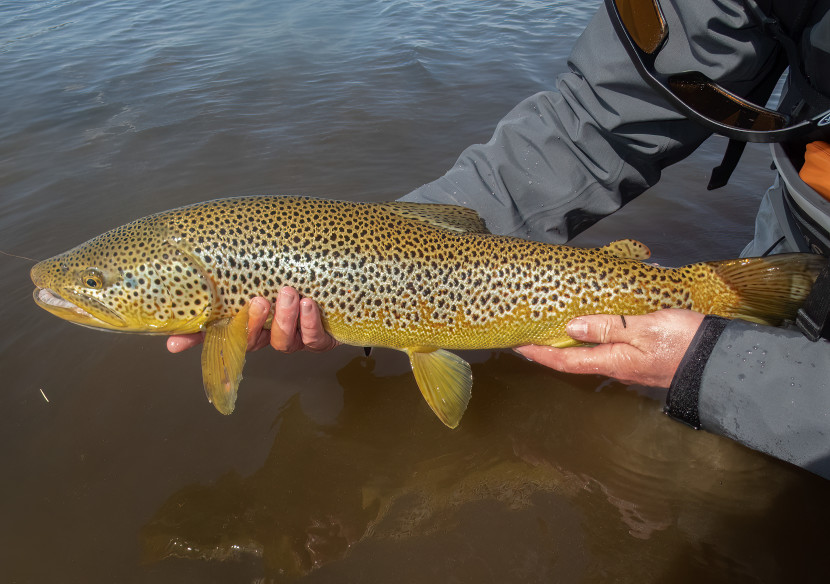 4.5lb brown trout, Iceland - Alan Parfitt
4.5lb brown trout, Iceland - Alan Parfitt 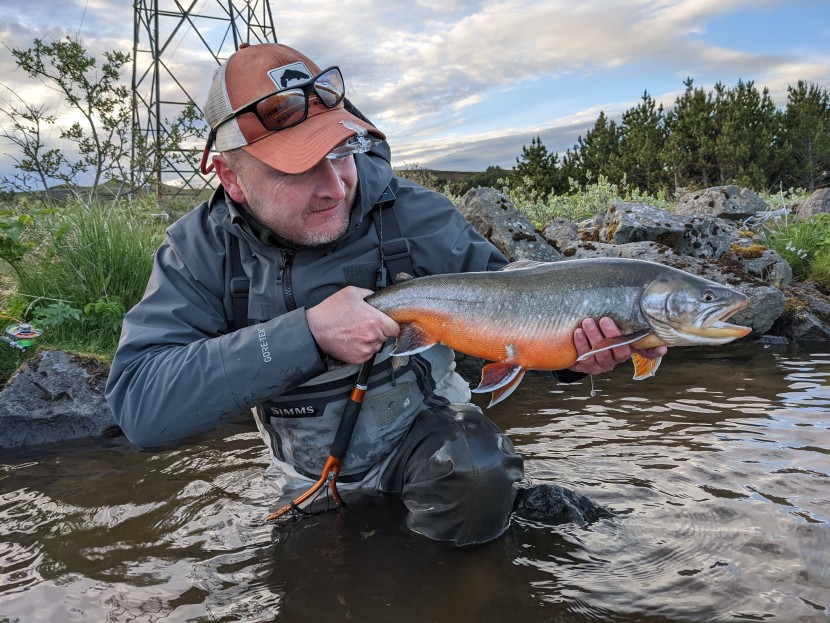 Lyn Davies with 7 pounds char, Iceland - Ceri Thomas
Lyn Davies with 7 pounds char, Iceland - Ceri Thomas 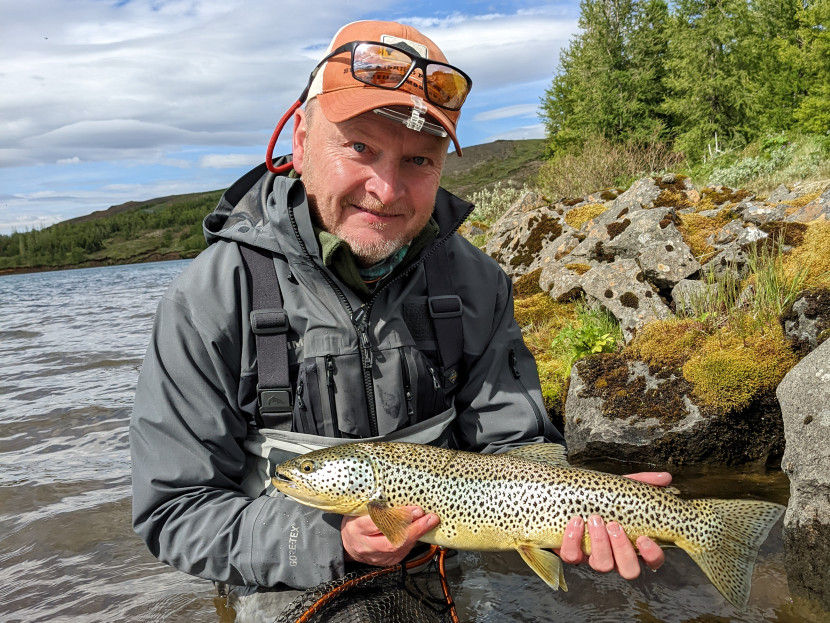 Lyn Davies with a 4lb brown trout, Iceland - Ceri Thomas
Lyn Davies with a 4lb brown trout, Iceland - Ceri Thomas 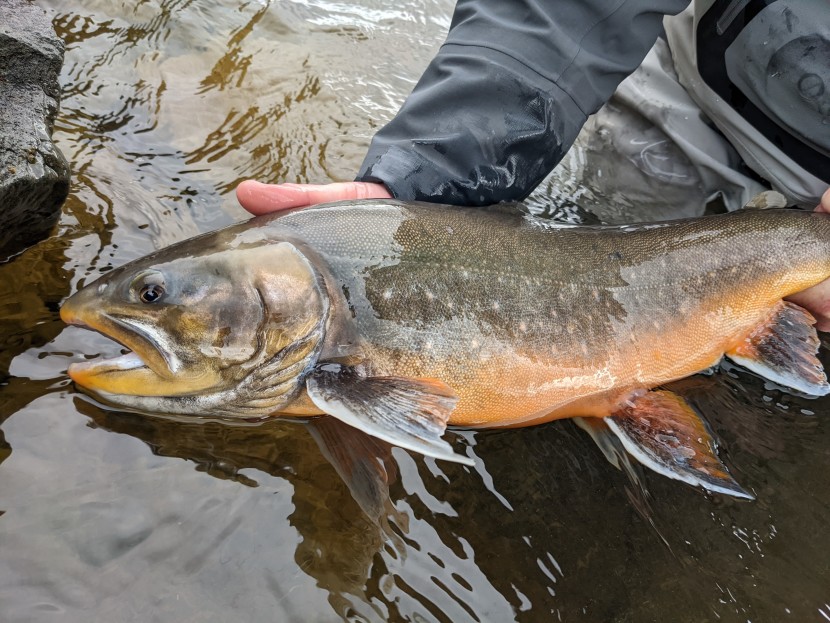 7lb char Iceland Ceri Thomas
7lb char Iceland Ceri Thomas